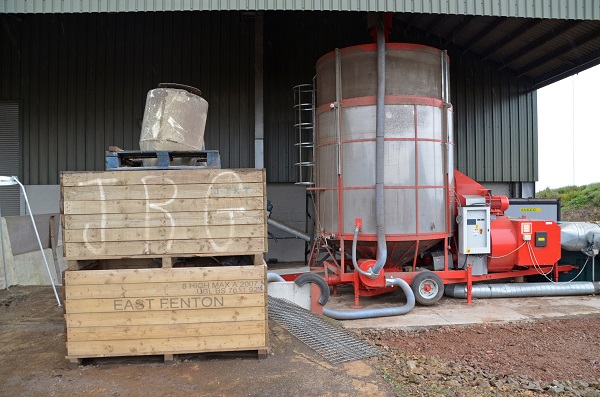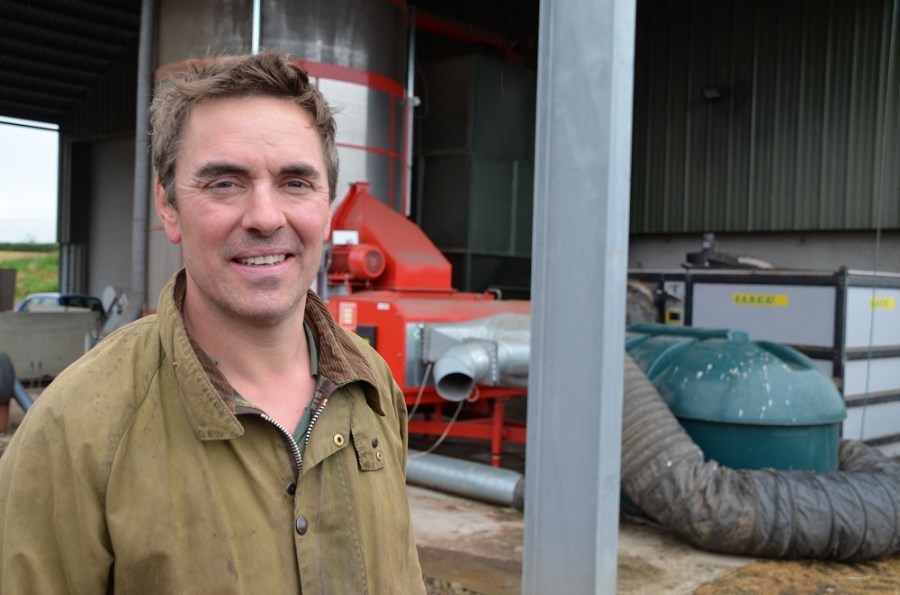An East Lothian grower has harnessed his farm’s woodland as an alternative energy source to dry grain. CPM reports.
There wasn’t any off-the-shelf dryer on sale in the UK that would run on woodchip.
By Nick Fone
With oil and gas prices becoming increasingly volatile, six years ago East Lothian grower Ben Gray decided it was time to take control of the farm’s energy bills – or at least part of them.
Growing cereals on Scotland’s east coast, there’s a certain inevitability about the need to dry grain and so it was the dryer fuel bill that he first set out to tackle.

The Opico/Lasco set-up will bring a 20t batch down from 20% to 15% moisture in around 2.5hrs.
With a green waste recycling and composting operation on site and 120ha of forestry, woodchip was quickly identified as the obvious alternative energy source.
“We’re fortunate to have the machinery to process wood waste and a decent acreage of woodland that needs managing so some sort of biomass burner seemed a sensible option,” explains Ben.
“But there wasn’t any off-the-shelf dryer on sale in the UK at that time that would run on woodchip so I started looking further afield. With my searches, one name that kept coming up was Austrian firm Lasco. They build a range of containerised air-to-air biomass burners that can be connected directly to an existing dryer.”
Having identified what seemed to be the best machine for the job, Mr Gray then set about some sums to calculate the exact costs and what the potential savings might be. With a 250kW Lasco furnace coming in at around £30,000, he was able to access a 50% grant from the Scottish Rural Development Programme. Going with this option meant that the set-up would not be eligible for Renewable Heat Incentive (RHI) payments but that was deemed sensible as the farm’s residential properties are a good distance from the grain store, making piping the heat to the buildings unfeasible.
“We liked the concept of a direct heat air-to-air burner because it can generate much higher temperatures than a water-based heat exchanger boiler and the heat output is much more readily adjusted. The figures stacked up and so we bit the bullet and ordered a Lasco burner. When it arrived it was simply a case of connecting it up to the air intake on our 12t Opico GT gas dryer with a 60cm diameter hose and wiring up a 12-volt signal feed to the burner control.
“It took very little modification to get it working and, with it warming the intake air to between 80-120°C, it immediately showed it was going to put a big dent in our gas bills. That first season we saw them drop by over 40%.”
Although the biomass burner is fully automated and computer controlled allowing Ben to set the temperature of the output air, the ten-year-old grain dryer was a completely manual machine so there was still the need to have someone on site all the time the set-up was running to switch the gas burners on and off manually.
“Over four seasons we proved the concept would work but we needed to make it a less labour-intensive operation. We also needed extra drying capacity so we decided to upgrade the dryer.
“So two years ago we ordered a fully-automated 20t Opico Magna, switching from gas to kerosene as our primary fuel. Again we did our own modifications but this time with a little more sophistication.”
At the point where the air delivery hose connects to the intake box on the front of the dryer Ben put together a manifold housing two sets of electronically adjusted louvres – one on the intake and another on an exhaust port. With the set-up running on a drying cycle the first set opens to send warm air directly through into the dryer’s main burn chamber. When it switches to its cooling cycle those louvres close and the ones on the exhaust outlet open, diverting the hot air out to one side where it can be used to dry woodchip or logs. At that point the dryer then starts to draw cool ambient air from below.
As regards throughput, the Opico/Lasco set-up will bring a 20t batch down from 20% to 15% moisture in around 2.5hrs. With a restriction on the use of glyphosate on the farm’s seed crops, green grains can be commonplace, pushing the sample to closer to 24% and extending the cycle to over four hours.
“We’ve got more control of the drying cycle and can dry more gently which is really important as most of our grain is for seed. We’ve also seen a huge difference in fuel efficiency. When the air is damp and cold, the Lasco means the oil burners don’t have to run nearly as often.
“With the woodchip burner running, the dryer will switch to high flame about every two minutes compared with every 40s when it’s on straight kerosene. That’s why we’ve seen our fuel bill drop by well over a third.”
The other big advantage of the Lasco biomass burner is that, being a containerised package, it can be moved when it’s not being used to dry grain and employed for other tasks such as space heating at public events or drying logs and hay – those are options that Mr Gray plans to explore to widen the unit’s working window.
Farm facts
JR Gray and Partners, North Berwick, East Lothian
- Farmed area:223ha
- Cropping: Winter wheat 93ha, spring wheat 57ha, ground rented out for potatoes and Brussels sprouts 57ha, wild bird cover and fallow 16ha, woodland 120ha
- Soils: Predominantly medium clay loams
- Mainline tractors: Fendt 818 and 718
- Loader: JCB 536-60
- Combine: Claas Tucano 460
- Sprayer: 3000-litre Chafer trailed with 28m booms
- Drier: 20t Opico Magna with 250kW Lasco LA250 woodchip burner
- Other renewables:2x 15kW C&F wind turbines; 50kW solar PV panels; 110kW Lindner and Sommerauer woodchip boiler for six properties
- Staff: Ben Gray plus one other full-time and another at harvest
Treat stores well ahead of harvest
Make sure grain stores are thoroughly cleaned and treated if necessary before harvest starts, to minimise the risk of pest infestations. That’s the advice from Peter Woolley of grain and store treatment specialists Alpha Fumigation.
“The cleaner the store the better,” he says. “It’s important to clear away any debris that may be harbouring mite or other store pests. Blow down any tunnels, vents and ducts and look out for hard-to-reach areas and crevices where debris may have collected.” Take care to clear areas where dust has settled or stuck to walls, he adds.
Alpha Fumigation offers a service to spray grain stores ahead of harvest, both preventatively and curatively. “Some farmers treat stores on an annual basis as a precaution, while others will treat if they’ve had a problem in the previous year. We have specialist equipment to reach heights of up to 14m,” he explains.
The two products he uses most are Talisma (cypermethrin) and K-Obiol (deltamethrin). “K-Obiol is more widely used, but we first used Talisma in 2014 and have continued to do so since because the product has performed consistently while being economically competitive.
“One of the main benefits is the range of application rates. You can also spray the grain directly on a movable belt or conveyor, or the storage facility.”
Arysta has carried out extra work on Talisma to show preventative control of mites when used at the higher rate, says the company’s Rob Adamson. “Cypermethrin affects neurons by blocking axonal conduction (IRAC 3A). Once in contact with the active, sodium channels are blocked in the open position through a phase of hyperexcitability followed by hypoexcitability, until end paralysis and death. It’s effective against most beetles, moths and mites.”
The Piperonyl butoxide (PBO) in the product has a synergic action with cypermethrin by inhibiting the enzyme which usually detoxifies the nerve cells after the cypermethrin is detected. This allow low doses of the active to build up inside the pest, and also helps to overcome resistance which can develop when low doses are involved.
“Talisma EC has a range of rates for grain treatment. There are also rates to allow the treatment of grain storage facilities as well as the actual grain,” confirms Rob.
“Due to the low residues, there is no withdrawal period for processing treated grain and the product is accepted by assurance schemes. Rotating and alternating insecticides in grain stores is good practice, particularly where organo-phosphates have been used.”
Faulty meters blamed for contract deductions
Malting barley growers have been urged to calibrate moisture meters ahead of harvest. According to Dr Julian South of the Maltsters Association of Great Britain (MAGB), some growers are failing to comply with contractual limits of grain moisture content.
“Every year there are far too many deliveries which when tested on the NIR Infratec, the standard instrument used across the malting barley industry for measuring grain moisture content, are found to contain up to 1% more moisture than the on-farm instrument suggests,” he says.
This results in delays in delivery to a maltings, and incurs penalties against the contract price to the grower. “It’s a totally unnecessary cost to the whole supply chain.”
Supply merchants blame on-farm moisture meters which are either incorrectly calibrated, or have not been freshly calibrated against new crop barley samples. This can be avoided by calibrating equipment to an NIR Infratec, suggests Julian. “Take sealed new crop samples to an NIR Infratec, and then test the same samples on the on-farm instrument. Alternatively, take the on-farm meter to a NIR Infratec.”
Julian’s advice is to re-check the calibration of the on-farm meters, perhaps every three months through the storage season. “Excess moisture content is not simply an issue of price penalties on delivery, it is also all about the potential deterioration of the quality of the barley in long term storage, including the development of mycotoxins.”
MAGB has issued guidelines to help growers ensure moisture meters are working correctly:
- Monitor the performance of your meter against a reference sample with known moisture content, if one is available.
- Ensure the instrument is clean of any contaminating residue before measurement, and be sure the sample is representative of the crop being measured.
- Take more than one reading (preferably more than one sample) and calculate an average result.
- Handle your meter carefully – store in an air-conditioned combine cab, if available. The sample and meter should be near to 20°C for most accurate measurement.




